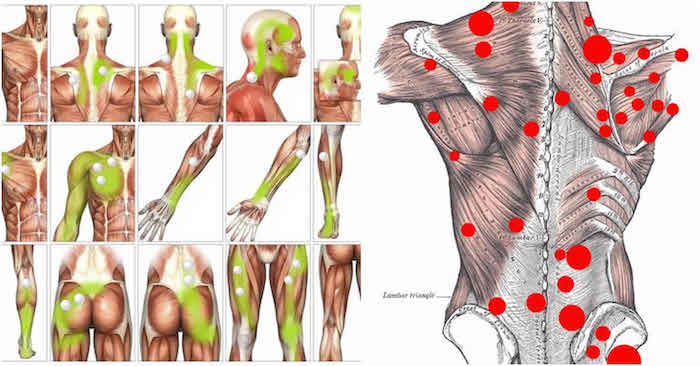
It’s been long known among the medical community that among the most common causes of pain are trigger points, also known as myofascitis or myofascial pain syndrome. Unfortunately, it’s also the most ignored health issue that doesn’t get much attention.
Even though physicians and expert chiropractors are aware of trigger points, in theory, very few of them know how to identify, locate, and treat them.
Trigger Points and How They Impact You
A trigger point is a very sensitive spot in your muscle that continuously sends pain signals to your brain via the nervous system. If you don’t seek immediate medical attention, it can eventually turn into a chronic pain issue.
Trigger points generally imitate tense muscle fibers or tiny hard knots. When pressed, they will feel painful. In most patients suffering from chronic lower back pain, trigger points are usually the culprit.
Some people have a tendency to ignore the painful spots on their bodies; they think the pain will go away on its own. But in the case of trigger points, the pain will only increase and worsen if left untreated. It may also lead to fatigue, food allergies, and other health issues if you don’t get it checked out.
Also, the ill effects of trigger points are not limited to pain. It can result in too much tension, causing your muscles to shorten. If one or more of your muscles are experiencing trigger points, you won’t be able to stretch those muscles to full length, and your range of motion will be reduced.
Moreover, it will also make your muscles weak. When a muscle has a trigger point, it faces resistance and thus, gets weaker with time. However, proper treatment and physical therapy routine can restore strength to the affected muscles.
Why You Should Seek Trigger Point Treatment
Other adverse effects of untreated trigger points include numbness and loss of coordination/balance in muscles. But these are all temporary issues that can be remedied with physical therapy. If you or your loved one is experiencing muscle weakness, shortness, or limited range of motion, it’s advised to consult with a skilled physical therapist or chiropractor right away.
Failure to treat and eliminate trigger points can lead to:
- Chronic pain
- Further injury
- Loss of muscle function and strength
- Disability
If the person suffering from trigger points is an older adult, it is critical for them to seek medical care and physical therapy for seniors, otherwise, it can cause permanent disability.
Trigger Point Symptoms
Here are some of the most common signs that trigger points might be present in your muscles:
- Diminished range of motion from muscle shortening
- Weakness in muscles (with/without atrophy)
- Involuntary trembling of muscle fibers
- Poor balance and/or coordination
- Excessive sweating in a particular spot, such as palms, face, underarms, etc.
These symptoms may go unnoticed within the general population, but they will be much more pronounced if you are an athlete. Trigger points are known to render athletes unable to perform optimally and, in some cases, are debilitating. Thankfully, physical therapy for athletes can help restore muscle strength and help achieve maximum performance.
Precision Pain Care and Rehabilitation has two convenient locations in Richmond Hill – Queens and New Hyde Park – Long Island. Call the Richmond Hill office at (718) 215-1888, or (516) 419-4480 for the Long Island office, to arrange an appointment with our Interventional Pain Management Specialist, Dr. Jeffrey Chacko.













